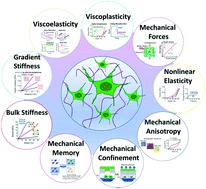当前位置:
X-MOL 学术
›
Biomater. Sci.
›
论文详情
Our official English website, www.x-mol.net, welcomes your
feedback! (Note: you will need to create a separate account there.)
Progress in the mechanical modulation of cell functions in tissue engineering
Biomaterials Science ( IF 5.8 ) Pub Date : 2020-10-20 , DOI: 10.1039/d0bm01255f Kamol Dey 1, 2, 3, 4, 5 , Elena Roca 6, 7, 8, 9, 10 , Giorgio Ramorino 5, 9, 10, 11 , Luciana Sartore 5, 9, 10, 11
Biomaterials Science ( IF 5.8 ) Pub Date : 2020-10-20 , DOI: 10.1039/d0bm01255f Kamol Dey 1, 2, 3, 4, 5 , Elena Roca 6, 7, 8, 9, 10 , Giorgio Ramorino 5, 9, 10, 11 , Luciana Sartore 5, 9, 10, 11
Affiliation

|
In mammals, mechanics at multiple stages—nucleus to cell to ECM—underlie multiple physiological and pathological functions from its development to reproduction to death. Under this inspiration, substantial research has established the role of multiple aspects of mechanics in regulating fundamental cellular processes, including spreading, migration, growth, proliferation, and differentiation. However, our understanding of how these mechanical mechanisms are orchestrated or tuned at different stages to maintain or restore the healthy environment at the tissue or organ level remains largely a mystery. Over the past few decades, research in the mechanical manipulation of the surrounding environment—known as substrate or matrix or scaffold on which, or within which, cells are seeded—has been exceptionally enriched in the field of tissue engineering and regenerative medicine. To do so, traditional tissue engineering aims at recapitulating key mechanical milestones of native ECM into a substrate for guiding the cell fate and functions towards specific tissue regeneration. Despite tremendous progress, a big puzzle that remains is how the cells compute a host of mechanical cues, such as stiffness (elasticity), viscoelasticity, plasticity, non-linear elasticity, anisotropy, mechanical forces, and mechanical memory, into many biological functions in a cooperative, controlled, and safe manner. High throughput understanding of key cellular decisions as well as associated mechanosensitive downstream signaling pathway(s) for executing these decisions in response to mechanical cues, solo or combined, is essential to address this issue. While many reports have been made towards the progress and understanding of mechanical cues—particularly, substrate bulk stiffness and viscoelasticity—in regulating the cellular responses, a complete picture of mechanical cues is lacking. This review highlights a comprehensive view on the mechanical cues that are linked to modulate many cellular functions and consequent tissue functionality. For a very basic understanding, a brief discussion of the key mechanical players of ECM and the principle of mechanotransduction process is outlined. In addition, this review gathers together the most important data on the stiffness of various cells and ECM components as well as various tissues/organs and proposes an associated link from the mechanical perspective that is not yet reported. Finally, beyond addressing the challenges involved in tuning the interplaying mechanical cues in an independent manner, emerging advances in designing biomaterials for tissue engineering are also explored.
中文翻译:

组织工程中细胞功能的机械调节研究进展
在哺乳动物中,从细胞发育到生殖再到死亡的多个阶段,从细胞核到细胞再到ECM的力学都是多种生理和病理功能的基础。在这种启发下,大量研究确立了力学的多个方面在调节基本细胞过程(包括传播,迁移,生长,增殖和分化)中的作用。但是,我们对如何在不同阶段协调或调整这些机械机制以维持或恢复组织或器官水平上健康环境的理解仍然是一个谜。在过去的几十年中,对周围环境的机械操纵进行了研究,这些环境称为衬底,基质或支架,在其上或内部,细胞已接种-在组织工程和再生医学领域中异常丰富。为此,传统的组织工程旨在将天然ECM的关键机械里程碑概括为基质,以指导细胞命运并朝着特定组织再生的方向起作用。尽管取得了长足的进步,但仍然存在一个大难题,那就是细胞如何将许多机械线索(例如刚度(弹性),粘弹性,塑性,非线性弹性,各向异性,机械力和机械记忆)计算为许多生物学功能。一种合作,受控和安全的方式。对关键细胞决策以及相关的机械敏感下游信号通路的高通量了解,以便根据独奏或组合的机械提示执行这些决策,对于解决此问题至关重要。尽管在调节细胞反应方面已经取得了许多有关机械线索的进展和理解的报告,尤其是机械强度的底物体积刚度和粘弹性,但仍缺乏完整的机械线索。这篇综述着重介绍了机械线索的综合观点,这些线索与调节许多细胞功能和随之而来的组织功能有关。为了获得非常基本的了解,概述了ECM的主要机械因素和机械转导过程的原理。此外,本综述收集了有关各种细胞和ECM组件以及各种组织/器官的硬度的最重要数据,并从机械角度提出了尚未报道的相关链接。最后,
更新日期:2020-11-05
中文翻译:

组织工程中细胞功能的机械调节研究进展
在哺乳动物中,从细胞发育到生殖再到死亡的多个阶段,从细胞核到细胞再到ECM的力学都是多种生理和病理功能的基础。在这种启发下,大量研究确立了力学的多个方面在调节基本细胞过程(包括传播,迁移,生长,增殖和分化)中的作用。但是,我们对如何在不同阶段协调或调整这些机械机制以维持或恢复组织或器官水平上健康环境的理解仍然是一个谜。在过去的几十年中,对周围环境的机械操纵进行了研究,这些环境称为衬底,基质或支架,在其上或内部,细胞已接种-在组织工程和再生医学领域中异常丰富。为此,传统的组织工程旨在将天然ECM的关键机械里程碑概括为基质,以指导细胞命运并朝着特定组织再生的方向起作用。尽管取得了长足的进步,但仍然存在一个大难题,那就是细胞如何将许多机械线索(例如刚度(弹性),粘弹性,塑性,非线性弹性,各向异性,机械力和机械记忆)计算为许多生物学功能。一种合作,受控和安全的方式。对关键细胞决策以及相关的机械敏感下游信号通路的高通量了解,以便根据独奏或组合的机械提示执行这些决策,对于解决此问题至关重要。尽管在调节细胞反应方面已经取得了许多有关机械线索的进展和理解的报告,尤其是机械强度的底物体积刚度和粘弹性,但仍缺乏完整的机械线索。这篇综述着重介绍了机械线索的综合观点,这些线索与调节许多细胞功能和随之而来的组织功能有关。为了获得非常基本的了解,概述了ECM的主要机械因素和机械转导过程的原理。此外,本综述收集了有关各种细胞和ECM组件以及各种组织/器官的硬度的最重要数据,并从机械角度提出了尚未报道的相关链接。最后,











































 京公网安备 11010802027423号
京公网安备 11010802027423号